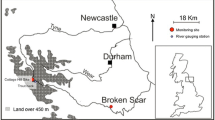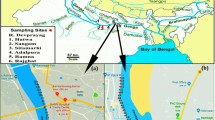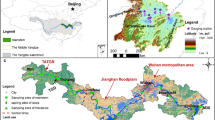Abstract
Water pollution disrupts the ecological integrity of urbanized river systems, but its impacts on riverine metabolic processes and carbon fluxes are poorly studied in developing countries. Three seasonal field surveys were combined with two high-resolution measurements and an in situ incubation experiment to investigate the effects of untreated wastewater on organic matter biodegradation and the partial pressure of CO2 (pCO2) along the Mekong–Tonle Sap network around Phnom Penh. High-resolution measurements during the dry-season survey exhibited large downstream increases in pCO2 along the Mekong reaches receiving Tonle Sap inflows carrying urban sewage, contrasting with little spatial variation during a monsoon survey when the Mekong floodwater reversed the Tonle Sap flow. The monsoonal and dry-season surveys revealed flooding-induced homogenization and large spatial divergences in dissolved organic carbon (DOC) concentration and its δ13C and Δ14C between the Tonle Sap and connected Mekong reaches. During the 3-day incubation of Mekong waters, alone or mixed with sewage, a large initial nocturnal increase in pCO2 in sewage-supplemented river water exceeded the subsequent daytime CO2 uptake by phytoplankton photosynthesis varying with light exposure. This, combined with the preferential consumption of labile DOC components displaying protein-like fluorescence, implies sewage-enhanced biodegradation of riverine organic matter. These results suggest that neglecting wastewater-enhanced CO2 production in urbanized river basins during long dry periods can result in a significant underestimation of riverine CO2 emissions.





Similar content being viewed by others
Data availability
Data are available and can be requested from the corresponding author (jhp@ewha.ac.kr).
References
Abril G, Nogueira E, Hetcheber H, Cabecadas G, Lemaire E, Brogueira MJ (2002) Behaviour of organic carbon in nine contrasting European estuaries. Estuar Coast Shelf Sci 54:241–262
Alin SR, Rasera MFFL, Salimon CI, Richey JE, Holtgrieve GW, Krusche AV, Snidvongs A (2011) Physical controls on carbon dioxide transfer velocity and flux in low-gradient river systems and implications for regional carbon budgets. J Geophys Res 116:G01009
Battin TJ, Luyssaert S, Kaplan LA, Aufdenkampe AK, Richter A, Tranvik LJ (2009) The boundless carbon cycle. Nature Geosci 2:598–600
Baum R, Luh J, Bartram J (2013) Sanitation: a global estimate of sewerage connections without treatment and the resulting impact on MDG progress. Environ Sci Technol 47:1994–2000
Begum MS et al (2019) Synergistic effects of urban tributary mixing on dissolved organic matter biodegradation in an impounded river system. Sci Total Environ 676:105–119
Begum MS et al (2021) Localized pollution impacts on greenhouse gas dynamics in three anthropogenically modified Asian river systems. J Geophys Res Biogeosci 126:e2020JG006124. https://doi.org/10.1029/2020JG006124
Bengtsson MM, Attermeyer K, Catalán N (2018) Interactive effects on organic matter processing from soils to the ocean: are priming effects relevant in aquatic ecosystems? Hydrobiologia 822:1–17. doi:https://doi.org/10.1007/s10750-018-3672-2
Bianchi TS (2011) The role of terrestrially derived organic carbon in the coastal ocean: a changing paradigm and the priming effect. Proc Natl Acad Sci USA 108:19473–19481. doi:https://doi.org/10.1073/pnas.1017982108
Bianchi TS, Thornton DC, Yvon-Lewis SA, King GM, Eglinton TI, Shields MR, Ward ND, Curtis J (2015) Positive priming of terrestrially derived dissolved organic matter in a freshwater microcosm system. Geophys Res Lett 42:5460–5467
Borges AV, Abril G, Bouillon S (2018) Carbon dynamics and CO2 and CH4 outgassing in the Mekong Delta. Biogeosciences 15:1093–1114
Campbell IC, Say S, Beardall J (2009) Tonle Sap Lake, the heart of the Lower Mekong. In: Campbell IC (ed) The Mekong—biophysical environment of an International River Basin. Elsevier, New York, pp 251–272
Cole JJ, Prairie YT, Caraco NF, McDowell WH, Tranvik LJ, Striegl RG, Duarte CM, Kortelainen P, Downing JA, Middelburg JJ, Melack J (2007) Plumbing the global carbon cycle: Integrating inland waters into the terrestrial carbon budget. Ecosystems 10:171–184
Crawford JT, Loken LC, Stanley EH, Stets EG, Dornblaser MM, Striegl RG (2016) Basin scale controls on CO2 and CH4 emissions from the Upper Mississippi River. Geophys Res Lett 43:1973–1979. doi:https://doi.org/10.1002/2015GL067599
Ellis EE, Keil RG, Ingalls AE, Richey JE, Alin SR (2012) Seasonal variability in the sources of particulate organic matter of the Mekong River as discerned by elemental and lignin analyses. J Geophys Res 117:G01038. doi:https://doi.org/10.1029/2011JG001816
Etcheber H, Taillez A, Aril G, Garnier J, Servais P, Moatar F, Commarieu M-V (2007) Particulate organic carbon in the estuarine turbidity maxima of the Gironde, Loire and Seine estuaries: origin and lability. Hydrobiologia 588:245–259
Fellman JB, Hood E, Spencer RGM (2010) Fluorescence spectroscopy opens new windows into dissolved organic matter dynamics in freshwater ecosystems: a review. Limnol Oceanogr 55:2452–2462. https://doi.org/10.4319/lo.2010.55.6.2452
Frankignoulle M, Abril G, Borges A, Bourge I, Canon C, Delille B, Libert E, Théate J-M (1998) Carbon dioxide emission from European estuaries. Science 282:434–436
Global Green Growth Institute (GGGI) (2019) Phnom Penh Sustainable City Plan 2018–2030. https://gggi.org/site/assets/uploads/2019/06/SUBSTAINABLE-CITY-REPORT_EN_FA3.pdf (accessed on February 19, 2021)
Griffith DR, Raymond PA (2011) Multiple-source heterotrophy fueled by aged organic carbon in an urbanized estuary. Marine Chem 124:14–22
Griffith DR, Barnes RT, Raymond PA (2009) Inputs of fossil carbon from wastewater treatment plants to US rivers and oceans. Environ Sci Technol 43:5647–5651
Guillemette F, del Giorgio PA (2012) Simultaneous consumption and production of fluorescent dissolved organic matter by lake bacterioplankton. Environ Microbiol 14:1432–1443
Guillemette F, McCallister SL, del Giorgio PA (2016) Selective consumption and metabolic allocation of terrestrial and algal carbon determine allochthony in lake bacteria. ISME J 10:1373–1382
Hosen JD, McDonough OT, Febria CM, Palmer MA (2014) Dissolved organic matter quality and bioavailability changes across an urbanization gradient in headwater streams. Environ Sci Technol 48:7817–7824
Hudson F (2004) Sample preparation and calculations for dissolved gas analysis in water samples using GC headspace equilibration technique, RSKSOP-175, Revision No, 2. U.S. Environmental Protection Agency, USA
Jin H, Yoon TK, Begum MS, Lee E-J, Oh N-H, Kang N, Park J-H (2018) Longitudinal discontinuities in riverine greenhouse gas dynamics generated by dams and urban wastewater. Biogeosciences 15:6349–6369. https://doi.org/10.5194/bg-15-6349-2018
Jung B-J, Jeanneau L, Alewell C, Kim B, Park J-H (2015) Downstream alteration of the composition and biodegradability of particulate organic carbon in a mountainous, mixed land-use watershed. Biogeochemistry 122:79–99. https://doi.org/10.1007/s10533-014-0032-9
Kempe S (1984) Sinks of the anthropogenically enhanced carbon-cycle in surface fresh waters. J Geophys Res 89:4657–4676. doi:https://doi.org/10.1029/JD089iD03p04657
Kim D, Begum M, Choi J, Jin H, Chea E, Park J-H (2019) Comparing effects of untreated and treated wastewater on riverine greenhouse gas emissions. APN Sci Bull 9:88–94. doi:https://doi.org/10.30852/sb.2019.872
Lauerwald R, Laruelle GG, Hartmann J, Ciais P, Regnier PAG (2015) Spatial patterns in CO2 evasion from the global river network. Global Biogeochem Cy 29:534–554. doi:https://doi.org/10.1002/2014GB004941
Li S, Lu XX, Bush RT (2013) CO2 partial pressure and CO2 emission in the Lower Mekong River. J Hydrol 504:40–56
Ludwig W, Probst J-L, Kempe S (1996) Predicting the oceanic input of organic carbon by continental erosion. Global Biogeochem Cy 10:23–41. doi:https://doi.org/10.1029/95GB02925
Martin EE, Ingalls AE, Richey JE, Keil RG, Santos GM, Truxal LT, Alin SR, Druffel ERM (2013) Age of riverine carbon suggests rapid export of terrestrial primary production in tropics. Geophys Res Lett 40:5687–5691. https://doi.org/10.1002/2013GL057450
McKnight DM, Boyer EW, Westerhoff PK, Doran PT, Kulbe T, Anderson DT (2001) Spectroflourometric characterization of dissolved organic matter for indication of precursor organic material and aromaticity. Limnol Oceanogr 46:38–48. https://doi.org/10.4319/lo.2001.46.1.0038
Mekong River Commission (2019) State of the Basin Report 2018, The Mekong River Commission, Vientiane, Lao PDR
Park J-H, Nayna OK, Begum MS, Chea E, Hartmann J, Keil RG, Kumar S, Lu X, Ran L, Richey JE, Sarma VVSS, Tareq SM, Xuan DT, Yu R (2018) Reviews and syntheses: Anthropogenic perturbations to carbon fluxes in Asian river systems—concepts, emerging trends, and research challenges. Biogeosciences 15:3049–3069. https://doi.org/10.5194/bg-15-3049-2018
Räsänen TA, Varis O, Scherer L, Kummu M (2016) Greenhouse gas emissions of hydropower in the Mekong River Basin. Environ Res Lett 13:034030
Raymond PA, Bauer JE (2001) Use of 14 C and 13 C natural abundances for evaluating riverine, estuarine, and coastal DOC and POC sources and cycling: a review and synthesis. Org Geochem 32:469–485. doi:https://doi.org/10.1016/S0146-6380(00)00190-X
Raymond PA, Hartmann J, Lauerwald R, Sobek S, McDonald, Hoover M, Butman D, Striegl R, Mayorga E, Humborg C, Kortelainen P, Dürr H, Meybeck M, Ciais P, Guth P (2013) Global carbon dioxide emissions from inland waters. Nature 503:355–359
Regnier P, Friedlingstein P, Ciais P et al (2013) Anthropogenic perturbation of carbon fluxes from land to ocean. Nature Geosci 6:597–607
Sabo JL, Ruhi A, Holtgrieve GW, Elliott V, Arias ME, Ngor PB, Räsänen TA, So N (2017) Designing river flows to improve food security futures in the Lower Mekong Basin. Science 358:eaao1053. DOI:https://doi.org/10.1126/science.aao1053
Satinsky BM, Smith CB, Sharma S, Ward ND, Krusche AV, Richey JE et al (2017) Patterns of bacterial and archaeal gene expression through the lower Amazon River. Front Mater Sci 4:253. doi:https://doi.org/10.3389/fmars.2017.00253
Stedmon CA, Bro R (2008) Characterizing dissolved organic matter fluorescence with parallel factor analysis: a tutorial. Limnol Oceanogr Methods 6:572–579. https://doi.org/10.4319/lom.2008.6.572
Stubbins A, Spencer RGM, Chen HM, Hatcher PG, Mopper K, Hernes PJ, Mwamba VL, Mangangu AM, Wabakanghanzi JN, Six J (2010) Illuminated darkness: Molecular signatures of Congo River dissolved organic matter and its photochemical alteration as revealed by ultrahigh precision mass spectrometry. Limnol Oceanogr 55(4):1467–1477
Stubbins A, Lapierre J-F, Berggren M, Prairie YT, Dittmar T, del Giorgio PA (2014) Environ Sci Technol 48:10598–10606. doi:https://doi.org/10.1021/es502086e
Ward CP, Nalven SG, Crump BC, Kling GW, Cory RM (2017) Photochemical alteration of organic carbon-draining permafrost soils shifts microbial metabolic pathways and stimulates respiration. Nature Comm 8:772
Ward ND, Keil RG, Medeiros PM, Brito DC, Cunha AC, Dittmar T et al (2013) Degradation of terrestrially derived macromolecules in Amazon River. Nat Geosci 6:530–533. doi:https://doi.org/10.1038/ngeo1817
Ward ND, Sawakuchi HO, Richey JE, Keil RG, Bianchi TS (2019) Enhanced aquatic respiration associated with mixing of clearwater tributary and turbid Amazon river waters. Front Earth Sci 7:101. doi:https://doi.org/10.3389/feart.2019.00101
Weishaar JL, Aiken GR, Bergamaschi BA, Fram MS, Fujii R, Mopper K (2003) Evaluation of specific ultraviolet absorbance as an indicator of the chemical composition and reactivity of dissolved organic carbon. Environ Sci Technol 37:4702–4708. https://doi.org/10.1021/es030360x
Yoon TK, Jin H, Oh N-H, Park J-H (2016) Technical note: Assessing gas equilibration systems for continuous pCO2 measurements in inland waters. Biogeosciences 13:3915–3930. https://doi.org/10.5194/bg-13-3915-2016
Yoon TK, Jin H, Begum MS, Kang N, Park JH (2017) CO2 outgassing from an urbanized river system fueled by wastewater treatment plant effluents. Environ Sci Technol 51:10459–10467. https://doi.org/10.1021/acs.est.7b02344
Zsolnay A, Baigar E, Jimenez M, Steinweg B, Saccomandi F (1999) Differentiating with fluorescence spectroscopy, the sources of dissolved organic matter in soils were subjected to drying. Chemosphere 38:45–50. https://doi.org/10.1016/S0045-6535(98)00166-0
Acknowledgements
We thank Sun-Hye Kim, Borami Park, Omme K. Nayna, Yewon Chun, Chhengngunn Aing, Zongta Sang, and many students at the Royal University of Phnom Penh for their assistance with sampling and sample analysis. We also gratefully acknowledge that Dr. Sanjeev Kumar at the Physical Research Laboratory helped us with the POC analysis and that Dr. Ishi Buffam and two anonymous reviewers provided us with helpful comments and suggestions.
Funding
This work was supported by the Asia-Pacific Network for Global Change Research (CRRP2016-01MY-Park) and the National Research Foundation of Korea funded by the Korean Government (NRF-2017R1D1A1B06035179).
Author information
Authors and Affiliations
Corresponding author
Ethics declarations
Conflict of interest
The authors declare that they have no conflicts of interest.
Additional information
Publisher’s Note
Springer Nature remains neutral with regard to jurisdictional claims in published maps and institutional affiliations.
Responsible Editor: Ishi Buffam.
Supplementary Information
Below is the link to the electronic supplementary material.
Rights and permissions
About this article
Cite this article
Park, JH., Jin, H., Yoon, T.K. et al. Wastewater-boosted biodegradation amplifying seasonal variations of pCO2 in the Mekong–Tonle Sap river system. Biogeochemistry 155, 219–235 (2021). https://doi.org/10.1007/s10533-021-00823-6
Received:
Accepted:
Published:
Issue Date:
DOI: https://doi.org/10.1007/s10533-021-00823-6




